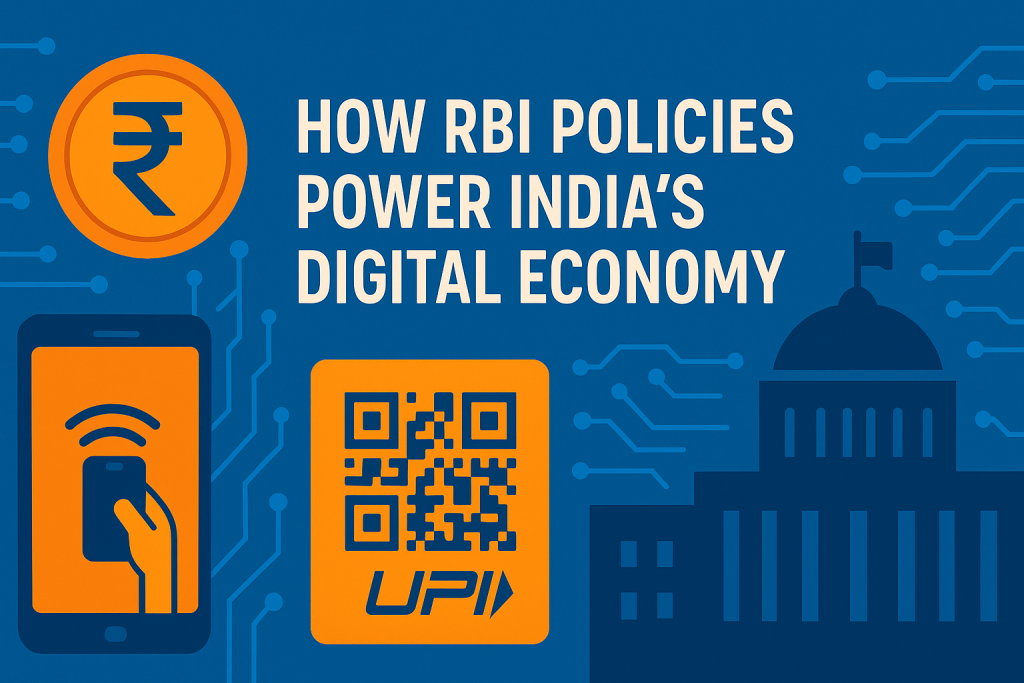India’s digital economy has grown at break-neck speed, and the Reserve Bank of India (RBI) now sits at the heart of that transformation. By setting clear rules for digital payments, nurturing fintech innovation in India and even piloting a central bank digital currency (CBDC), the RBI shapes how every Indian pays, saves and borrows.

The poster-child of this policy success is the Unified Payments Interface (UPI). In May 2025 the rail processed 18.68 billion transactions worth ₹25.14 lakh crore, a level that makes India the world’s busiest real-time payments market.
What made such scale possible is the RBI’s Payments Vision 2025, anchored on five “I” pillars—Integrity, Inclusion, Innovation, Institutionalisation and Internationalisation. The document sets measurable targets such as tripling digital payment volumes and exporting Indian payment rails abroad, giving start-ups a public roadmap around which to build products.
To keep pace with lightning-fast technology shifts, the RBI carved out a dedicated Fintech Department in January 2022. By subsuming the old fintech cell into a full departmental structure, the central bank created a single window for sandbox approvals, global collaboration and policy consultation—speeding up time-to-market for everything from tap-to-phone to connected-car payments.
Rapid growth also brought risks, especially in digital lending. After an explosion of predatory loan apps, the RBI issued sweeping Digital Lending Guidelines in September 2022. The circular insists that loans be booked on a regulated entity’s balance sheet, mandates direct disbursal to borrowers’ bank accounts, caps default-loss guarantees and tightens data-sharing rules. The result is a safer yet still dynamic lending environment.
Perhaps the boldest experiment is the retail e-rupee. By March 2025 the CBDC pilot had crossed 60 lakh users and 17 partner banks, while testing offline and programmable features—vital for rural adoption and smart-contract payouts. Fintech platform Cred even became the first non-bank to integrate an e-rupee wallet, underlining the RBI’s intent to let private innovation bloom on sovereign rails just as it did with UPI.
These policies have lowered friction, boosted trust and attracted some of the world’s largest venture cheques despite a global funding winter. Yet challenges remain: cyber-security threats grow with scale, broadband gaps persist and grievance redress needs constant strengthening. The RBI’s consultative style—release a discussion paper, run pilots, tweak rules—helps correct course without stifling new ideas.
Looking ahead, expect deeper cross-border UPI linkages, stricter AI governance norms and a refined framework for Buy-Now-Pay-Later 2.0. For consumers, founders and investors, understanding the RBI digital economy playbook is no longer optional; it is the lens through which India’s next wave of digital innovation will pass.
ixamBee specializes in providing expert guidance and resources for banking exams 2025, ensuring that you are well-prepared for the Upcoming Bank Exams like RBI Grade B, NABARD Grade B, IBPS SO, and more. Our courses align with the bank exam calendar 2024, covering all the essential topics. With a focus on the upcoming bank jobs, our Previous Year Papers, BeePedia, SSC CGL, SSC CHSL, SSC MTS and other Mock Tests are designed to help you excel in upcoming banking exams.















![RBI Governors List With Name And Tenure [Updated 2023] List of RBI Governors, Updated list of RBI Governors, RBI Governor List 2023](/blog/wp-content/uploads/2023/10/35-100x70.png)